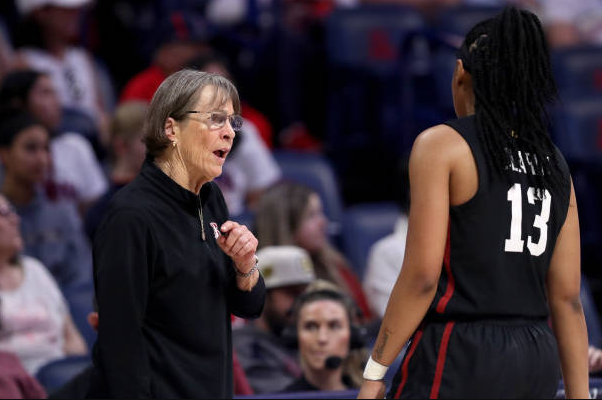In a poignant moment following Stanford’s triumph over Oregon State in the conference tournament semifinals, Coach Tara VanDerveer expressed a bold wish for the upcoming Final Four: to see four Pac-12 teams make the cut.
Yet, her senior player, Hannah Jump, couldn’t help but laughingly dissent. “I wouldn’t,” she silently mouthed, reflecting a sentiment shared by many within the Pac-12.
Jump’s reaction epitomized a collective eagerness for fresh challenges beyond the familiar battlegrounds of conference play.
While the Pac-12 had been a crucible of intense competition, pitting teams against each other with relentless fervor, it also served as a preparation ground for the rigors of the NCAA tournament.
Coach VanDerveer’s Bold Final Four Wish

Throughout the season, Pac-12 teams had navigated a diverse array of playing styles, from intricate Princeton offenses to formidable two-post lineups and individual scoring prowess.
This diversity not only tested their resilience but also equipped them with a confidence that would prove invaluable on the national stage.
Assistant coach Gavin Peterson of Utah, a seasoned observer of Pac-12 dynamics, extolled the unique benefits of facing varied offenses within the conference.
Such exposure, he argued, honed teams’ adaptability and strategic acumen, essential traits for postseason success.
Arizona’s Coach Adia Barnes echoed Peterson’s sentiments, lauding the depth of coaching talent and tactical diversity present in the Pac-12. In a league teeming with skilled tacticians and distinct team identities, adaptability became paramount—a lesson that would serve Pac-12 teams well as they ventured into NCAA territory.
With seven Pac-12 teams projected to secure tournament bids, including perennial powerhouses like Stanford and USC, the conference stood as a formidable force on the national stage.
Yet, it was not merely the quantity of bids but the quality of competition within the Pac-12 that set it apart.
The Pac-12’s grueling schedule, characterized by relentless battles against ranked opponents, had been a baptism by fire for teams like Oregon State.
Next: Paul George Settles ROY Debate: Clippers’ Star Chooses Between Wembanyama and Holmgren
Pac-12 Teams’ Journey Through the NCAA Tournament
Despite facing a gauntlet of top-tier foes, the Beavers emerged as a formidable contender—a testament to the resilience fostered in the crucible of conference play.
As the postseason beckoned, teams like Utah exemplified the meticulous preparation required to navigate Pac-12 challenges.
From strategic scouting reports to defensive adjustments tailored to opponents’ strengths, every detail was meticulously scrutinized in a conference where margins for error were razor-thin.
For Stanford, success lay in leveraging its own strengths, notably its formidable post presence led by Cameron Brink and Kiki Iriafen.
This dynamic duo posed a matchup nightmare for opponents, epitomizing the depth of talent within the Pac-12 ranks.
As Pac-12 teams braced themselves for the NCAA tournament, they carried with them a quiet confidence forged in the crucible of conference competition.
For players like Jump, the battles waged on familiar courts had instilled a belief—a belief that they were prepared to take on any challenge, no matter how daunting, and emerge victorious.
Read Next: Lakers Race to Fix Embarrassing Spelling Errors on Kobe Bryant Statue
